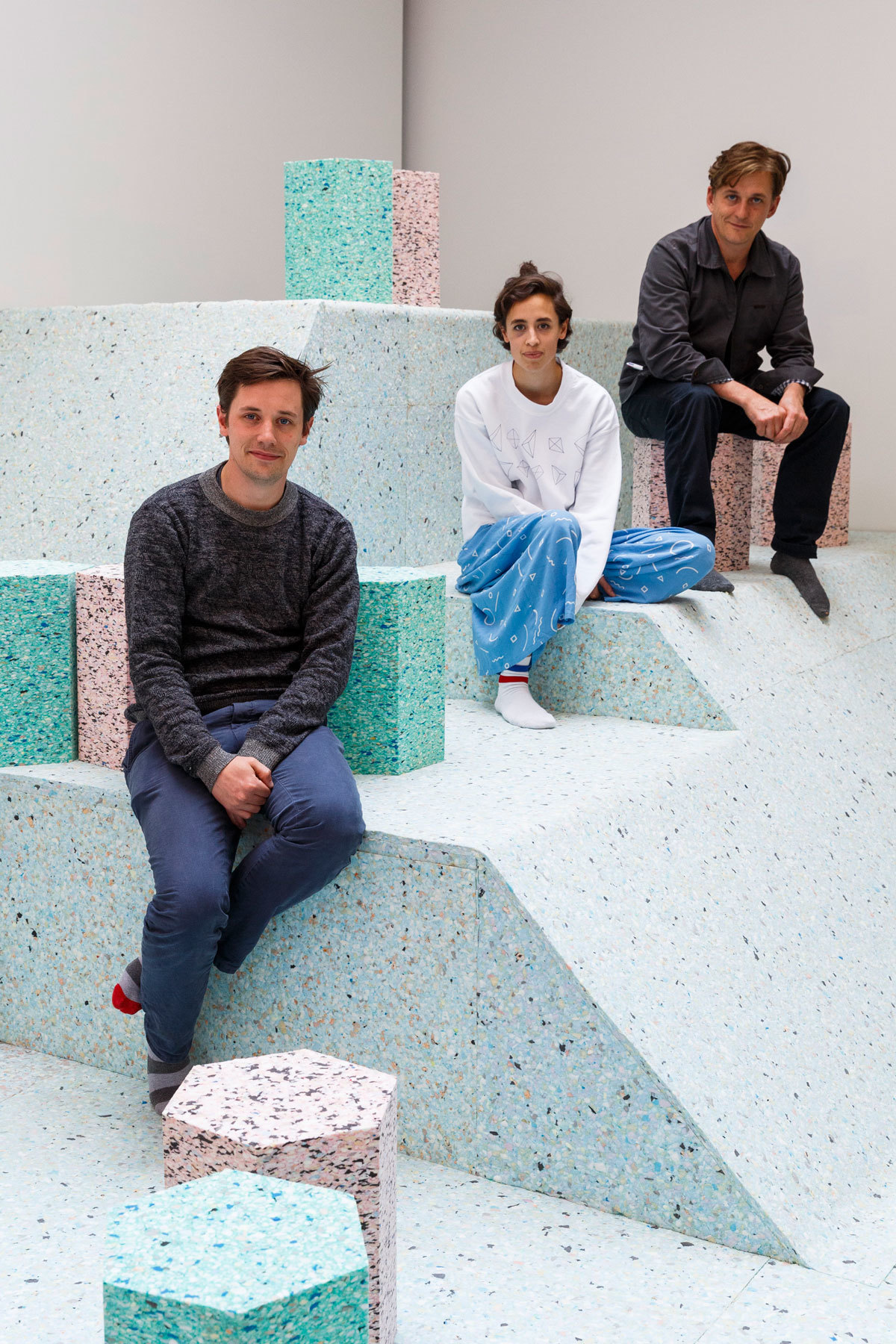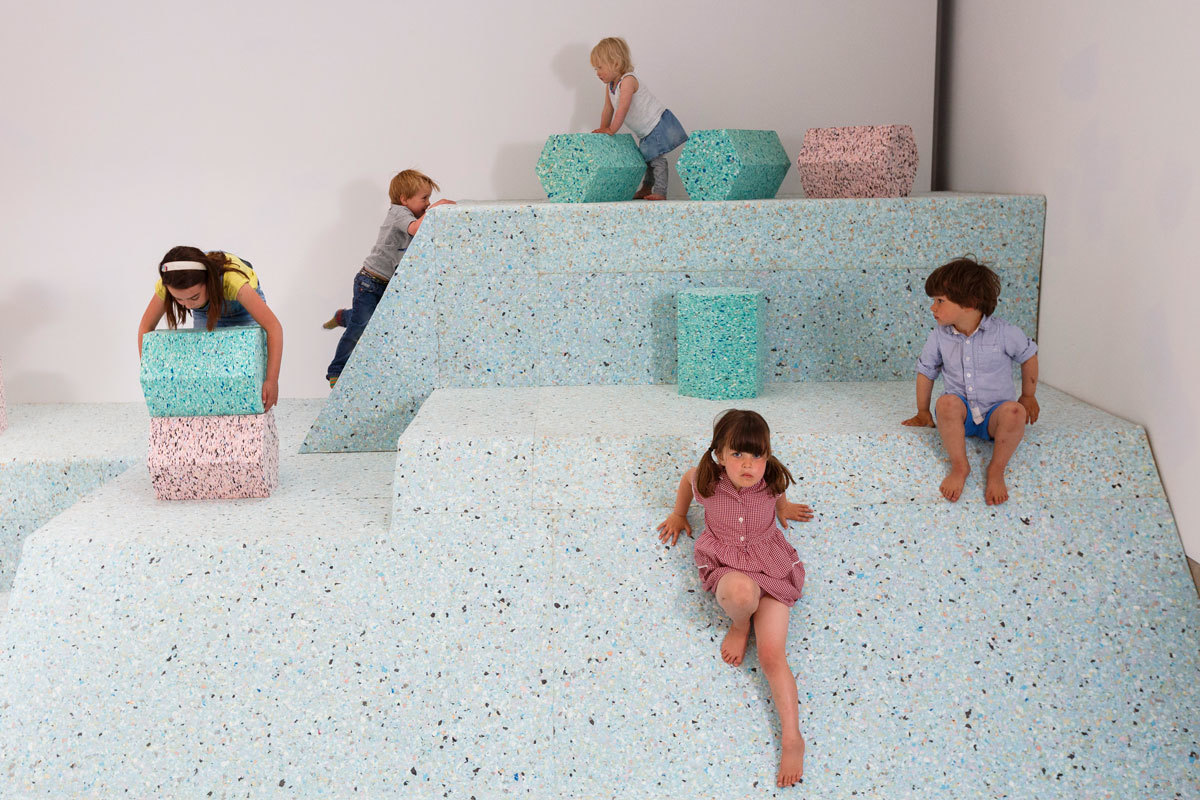One of the 20th century’s most controversial architectural movements, Brutalism was a severe visual style of massive edifices and an austere approach to building, glorifying rawness of material like brick and concrete. Typified by the concrete tower block and the multi-story carpark, its stars in London include the Balfron Tower, Churchill Gardens, Trellick Tower, the Royal Festival Hall and the Barbican.
Assemble’s Brutalist Playground sounds like a dark joke or sadist’s wonderland. The housing estates that fell into dereliction in the 80s and 90s are now better remembered for social alienation than the utopian idealism that built them, but several were once accompanied by Modernist playscapes for kids featuring retro-futurist structures like concrete flying saucers and mammoth abstract shapes to roam about in.
With artist photographer Simon Terrill, Assemble have resurrected these forgotten structures swapping concrete for candyfloss colour foam, “like concrete on an acid trip – it’s slightly weird,” according to Joe Halligan one of a pair who, with Jane Hall, is leading the project for Assemble’s 18-strong collective.

Their child-safe soft Brutalism plays out a satiric commentary on risk-averse 21st century attitudes to children and public spaces. “Playgrounds today are all brightly coloured and scream ‘PLAY HERE!'” says Joe. “The idea that a child can climb a tree and fall off and learn from it–and that moulds who they are–is interesting.”
As Brutalist estates crumbled in the 80s and became associated with broken dreams, design-heavy Brutalist playgrounds were replaced with generic seesaws, slides and soft surfaces.”It wasn’t just a change of fashion, it was an explicit decision that this kind of thing is bad.” Most of the Brutalist play structures were torn down, so we don’t know which was better. “Maybe they were crap?” Joe explains. Assemble’s foam reimagining gives people a place to revisit and try out the soft surface adventure playground and consider for themselves.
You get a sense that Assemble admire the Brutalist commitment to experimentation, and dreaming of a new built world, and are suspect of the hierarchy, rules and top-down regeneration that determine building and influence community today. As a group of people working across art, design and architecture, Assemble don’t really fit in with either the official architecture or art worlds; their projects deeply involve the real people who will live within and experience them, and though they may sometimes take form in galleries and art institutions, they couldn’t be described as practicing artists in the way most other Turner Prize nominees are.
And while their work is gaining recognition from major institutions, they’re still feeling their way out as they go along. Their loose, informal philosophy suits an era preoccupied with democratising use of space and organisation. Which is reflected in the way they work, as eighteen creatives, in a completely ‘flat’ organisational structure in which each voice is equal.

“There is no direction!” Joe explains. “We are a highly inefficient practice. But that works in a way. Loads of talking and over-investment from people.”
The collective are based at the Sugarhouse in Bow, which is their office-studio, if you like. “We’re isolated slightly from the world. There’s nowhere to eat lunch, only a MacDonalds. So through having lunch together in-house everyday there’s a lots of discussion.”
Assemble is a good name both for the collective and their loose transient approach to construction. There’s a temporary, flexible, interpretative quality to a lot of their projects. They’ve made temporary event spaces in London like The Cineroleum in Clerkenwell and Folly For A Flyover in Hackney Wick. They’ve dabbled with cinemas, clubs, theatres, and cafes. The project that got them the Turner nomination revived an abandoned street in the Liverpool neighbourhood of Toxteth, famous for the 1981 riots brought on by racism and poverty. Working with local people in a kind of accelerated artist-assisted gentrification scheme that made the area safe and liveable in again. Unlike many architecture practices they’re able to cut to the chase and make real social impact. And they’re not the kind to be imposing a vision on the world or making massive statements.
“It was fair to say it was a surprise,” Joe says, of their nomination, and some members of the collective weren’t sure whether to even accept. “But it feels it came out of this idea from one of the judges of useful art – that art can be used to do stuff.”
Though they recognise it’d be much easier to have someone at the top directing their project choices, the flat structure works because they know each other well enough, their specialisms and personalities, and they really want it to.
“If two people want to do a project, as long as it makes financial sense…” says Louis Schulz, another Assemble member who’s helping out with the RIBA installation.”It doesn’t even have to make sense!” Joe interjects. “…there are very few reasons why we would impose and say – no you can’t do that. We’re not about that,” Louis continuees. “Do you know what I mean?”
Credits
Text Sharon Thiruchelvam
Photography Tristan Fewings
Archive image of Churchill Gardens John Donat, courtesy the RIBA Library
